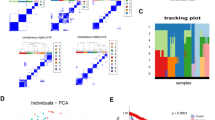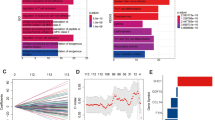Abstract
Osteosarcoma (OSA) is one of the most common malignancies in humans (especially children) and dogs. Canine OSA is considered an ideal model of human OSA because OSA in both species shares comparable oncogenic properties—including histopathological features, tumor biology, therapeutic approaches, and molecular mechanisms. In this study, we sought to compare the expression profiles of embryonic stem cell (ES) gene signatures in canine and human OSA tissues and cell lines. The expression patterns of three major ES gene signatures (modules or gene sets)—namely Myc, Core, and PRC modules—were primarily analyzed through the gene set enrichment analysis method in three gene expression datasets. For verification of the primary results, an additional 13 ES gene sets which were categorized into four groups—namely NOS targets, ES expressed, Myc targets, and Polycomb targets—were evaluated in expression datasets. Additionally, the prognostic efficacy of the gene sets with a similar enrichment pattern in humans and dogs was evaluated using the Cox proportional hazard model. Our results revealed that there were similar ES module expression patterns in the human OSA tissue and cell line, where the MYC modules, Myc targets, ES exp1, and NOS target modules were upregulated and the Polycomb target modules were downregulated in both entities. The canine OSA cell line showed ES enrichment patterns more similar to the patterns in its human counterpart, where we were able to detect the upregulation of the MYC modules, Myc targets, ES exp1, and NOS target modules and the downregulation of the Polycomb targets, including H3K27 bound and PRC2 targets. However, the canine OSA tissues presented a similar enrichment pattern at a lower degree than the canine OSA cell line. Furthermore, survival analysis identified the NOS targets as a more robust prognostic gene signature that efficiently predicted survival time in the human and canine OSA samples.






Similar content being viewed by others
References
Argyle DJ, Brearley MJ, Turek MM (2009) Decision making in small animal oncology. John Wiley & Sons, New York
Atlasi Y, Mowla SJ, Ziaee SAM, Bahrami A-R (2007) OCT-4, an embryonic stem cell marker, is highly expressed in bladder cancer. Int J Cancer 120:1598–1602
Baird K, Davis S, Antonescu CR, Harper UL, Walker RL, Chen Y, Glatfelter AA, Duray PH, Meltzer PS (2005) Gene expression profiling of human sarcomas: insights into sarcoma biology. Cancer Res 65:9226–9235
Bass AJ, Watanabe H, Mermel CH, Yu S, Perner S, Verhaak RG, Kim SY, Wardwell L, Tamayo P, Gat-Viks I, Ramos AH, Woo MS, Weir BA, Getz G, Beroukhim R, O'Kelly M, Dutt A, Rozenblatt-Rosen O, Dziunycz P, Komisarof J, Chirieac LR, Lafargue CJ, Scheble V, Wilbertz T, Ma C, Rao S, Nakagawa H, Stairs DB, Lin L, Giordano TJ, Wagner P, Minna JD, Gazdar AF, Zhu CQ, Brose MS, Cecconello I, Jr UR, Marie SK, Dahl O, Shivdasani RA, Tsao M-S, Rubin MA, Wong KK, Regev A, Hahn WC, Beer DG, Rustgi AK, Meyerson M (2009) SOX2 is an amplified lineage-survival oncogene in lung and esophageal squamous cell carcinomas. Nat Genet 41:1238–1242
Beachy PA, Karhadkar SS, Berman DM (2004) Tissue repair and stem cell renewal in carcinogenesis. Nature 432:324–331
Ben-Porath I, Thomson MW, Carey VJ, Ge R, Bell GW, Regev A, Weinberg RA (2008) An embryonic stem cell-like gene expression signature in poorly differentiated aggressive human tumors. Nat Genet 40:499–507
Dhaini HR, Thomas DG, Giordano TJ, Johnson TD, Biermann JS, Leu K, Hollenberg PF, Baker LH (2003) Cytochrome P450 CYP3A4/5 expression as a biomarker of outcome in osteosarcoma. J Clin Oncol 21:2481–2485
Ferracini R, Angelini P, Cagliero E, Linari A, Martano M, Wunder J, Buracco P (2000) MET oncogene aberrant expression in canine osteosarcoma. J Orthop Res 18:253–256
Flint AF, U'Ren L, Legare ME, Withrow SJ, Dernell W, Hanneman WH (2004) Overexpression of the erbB-2 proto-oncogene in canine osteosarcoma cell lines and tumors. Vet Pathol 41:291–296
Gajjar K, Martin-Hirsch PL, Martin FL (2012) CYP1B1 and hormone-induced cancer. Cancer Lett 324:13–30
Gatta G, Capocaccia R, Stiller C, Kaatsch P, Berrino F, Terenziani M, Group EW (2005) Childhood cancer survival trends in Europe: a EUROCARE Working Group study. J Clin Oncol 23:3742–3751
Gautier L, Cope L, Bolstad BM, Irizarry RA (2004) affy—analysis of Affymetrix GeneChip data at the probe level. Bioinformatics 20:307–315
Gidekel S, Pizov G, Bergman Y, Pikarsky E (2003) Oct-3/4 is a dose-dependent oncogenic fate determinant. Cancer Cell 4:361–370
Huang DW, Sherman BT, Lempicki RA (2009) Systematic and integrative analysis of large gene lists using DAVID bioinformatics resources. Nat Protoc 4:44–57
Jaffe N (2009) Adjuvant chemotherapy in osteosarcoma: an odyssey of rejection and vindication. Cancer Treat Res 152:219–237
Kawahara T, Hotta N, Ozawa Y, Kato S, Kano K, Yokoyama Y, Nagino M, Takahashi T, Yanagisawa K (2013) Quantitative proteomic profiling identifies DPYSL3 as pancreatic ductal adenocarcinoma-associated molecule that regulates cell adhesion and migration by stabilization of focal adhesion complex. PLoS One 8:e79654
Kim J, Woo AJ, Chu J, Snow JW, Fujiwara Y, Kim CG, Cantor AB, Orkin SH (2010) A Myc network accounts for similarities between embryonic stem and cancer cell transcription programs. Cell 143:313–324
Kim S-K, Hwan Kim J, Yun S-J, Kim W-J, Kim S-Y (2014) APPEX: analysis platform for the identification of prognostic gene expression signatures in cancer. Bioinformatics 30:3284–3286
Klopfleisch R, Klose P, Weise C, Bondzio A, Multhaup G, Einspanier R, Gruber AD (2010a) Proteome of metastatic canine mammary carcinomas: similarities to and differences from human breast cancer. J Proteome Res 9:6380–6391
Klopfleisch R, Lenze D, Hummel M, Gruber AD (2010b) Metastatic canine mammary carcinomas can be identified by a gene expression profile that partly overlaps with human breast cancer profiles. BMC Cancer 10:618
Levine RA, Forest T, Smith C (2002) Tumor suppressor PTEN is mutated in canine osteosarcoma cell lines and tumors. Vet Pathol 39:372–378
Lossos IS, Czerwinski DK, Alizadeh AA, Wechser MA, Tibshirani R, Botstein D, Levy R (2004) Prediction of survival in diffuse large-B-cell lymphoma based on the expression of six genes. N Engl J Med 350:1828–1837
Mendoza S, Konishi T, Dernell WS, Withrow SJ, Miller CW (1998) Status of the p53, Rb and MDM2 genes in canine osteosarcoma. Anticancer Res 18:4449–4453
Miyato H, Tsuno NH, Kitayama J (2012) Semaphorin 3C is involved in the progression of gastric cancer. Cancer Sci 103:1961–1966
Mizuno H, Spike BT, Wahl GM, Levine AJ (2010) Inactivation of p53 in breast cancers correlates with stem cell transcriptional signatures. Proc Natl Acad Sci U S A 107:22745–22750
O’Donoghue LE, Ptitsyn AA, Kamstock DA, Siebert J, Thomas RS, Duval DL (2010) Expression profiling in canine osteosarcoma: identification of biomarkers and pathways associated with outcome. BMC Cancer 10:506
Ollins GJ, Nikitakis N, Norris K, Herbert C, Siavash H, Sauk JJ (2002) The production of the endostatin precursor collagen XVIII in head and neck carcinomas is modulated by CBP2/Hsp47. Anticancer Res 22:1977–1982
Padden J, Megger DA, Bracht T, Reis H, Ahrens M, Kohl M, Eisenacher M, Schlaak JF, Canbay AE, Weber F, Hoffmann A-C, Kuhlmann K, Meyer HE, Baba HA, Sitek B (2014) Identification of novel biomarker candidates for the immunohistochemical diagnosis of cholangiocellular carcinoma. Mol Cell Proteomics 13:2661–2672
Pang LY, Gatenby EL, Kamida A, Whitelaw BA, Hupp TR, Argyle DJ (2014) Global gene expression analysis of canine osteosarcoma stem cells reveals a novel role for COX-2 in tumour initiation. PLoS One 9:e83144
Paoloni M, Davis S, Lana S, Withrow S, Sangiorgi L, Picci P, Hewitt S, Triche T, Meltzer P, Khanna C (2009) Canine tumor cross-species genomics uncovers targets linked to osteosarcoma progression. BMC Genomics 10:625
Paoloni M, Khanna C (2008) Translation of new cancer treatments from pet dogs to humans. Nat Rev Cancer 8:147–156
Rainusso N, Man T-K, Lau CC, Hicks J, Shen JJ, Yu A, Wang LL, Rosen JM (2011) Identification and gene expression profiling of tumor-initiating cells isolated from human osteosarcoma cell lines in an orthotopic mouse model. Cancer Biol Ther 12:278–287
Reya T, Morrison SJ, Clarke MF, Weissman IL (2001) Stem cells, cancer, and cancer stem cells. Nature 414:105–111
Schetter AJ, Nguyen GH, Bowman ED, Mathé EA, Yuen ST, Hawkes JE, Croce CM, Leung SY, Harris CC (2009) Association of inflammation-related and microRNA gene expression with cancer-specific mortality of colon adenocarcinoma. Clin Cancer Res 15:5878–5887
Schoenhals M, Kassambara A, De Vos J, Hose D, Moreaux J, Klein B (2009) Embryonic stem cell markers expression in cancers. Biochem Biophys Res Commun 383:157–162
Schroder MS, Culhane AC, Quackenbush J, Haibe-Kains B (2011) survcomp: an R/Bioconductor package for performance assessment and comparison of survival models. Bioinformatics 27:3206–3208
Scott MC, Sarver AL, Gavin KJ, Thayanithy V, Getzy DM, Newman RA, Cutter GR, Lindblad-Toh K, Kisseberth WC, Hunter LE, Subramanian S, Breen M, Modiano JF (2011) Molecular subtypes of osteosarcoma identified by reducing tumor heterogeneity through an interspecies comparative approach. Bone 49:356–367
Selvarajah GT, Kirpensteijn J, van Wolferen ME, Rao NAS, Fieten H, Mol JA (2009) Gene expression profiling of canine osteosarcoma reveals genes associated with short and long survival times. Mol Cancer 8:72
Shats I, Gatza ML, Chang JT, Mori S, Wang J, Rich J, Nevins JR (2011) Using a stem cell-based signature to guide therapeutic selection in cancer. Cancer Res 71:1772–1780
Subramanian A, Tamayo P, Mootha VK, Mukherjee S, Ebert BL, Gillette MA, Paulovich A, Pomeroy SL, Golub TR, Lander ES, Mesirov JP (2005) Gene set enrichment analysis: a knowledge-based approach for interpreting genome-wide expression profiles. Proc Natl Acad Sci U S A 102:15545–15550
Tan F, Wahdan-Alaswad R, Yan S, Thiele CJ, Li Z (2013) Dihydropyrimidinase-like protein 3 expression is negatively regulated by MYCN and associated with clinical outcome in neuroblastoma. Cancer Sci 104:1586–1592
Thomas R, Wang HJ, Tsai P-C, Langford CF, Fosmire SP, Jubala CM, Getzy DM, Cutter GR, Modiano JF, Breen M (2009) Influence of genetic background on tumor karyotypes: evidence for breed-associated cytogenetic aberrations in canine appendicular osteosarcoma. Chromosom Res 17:365–377
Vaitkienė P, Skiriutė D, Steponaitis G, Skauminas K, Tamašauskas A, Kazlauskas A (2015) High level of Sema3C is associated with glioma malignancy. Diagn Pathol 10:58
Wong DJ, Liu H, Ridky TW, Cassarino D, Segal E, Chang HY (2008) Module map of stem cell genes guides creation of epithelial cancer stem cells. Cell Stem Cell 2:333–344
Young JL, Miller RW (1975) Incidence of malignant tumors in U. S. children. J Pediatr 86:254–258
Zamani-Ahmadmahmudi M (2016a) Embryonic stem cell gene expression signatures in the canine mammary tumor: a bioinformatics approach. APMIS 124:659–668
Zamani-Ahmadmahmudi M (2016b) Relationship between microRNA genes incidence and cancer-associated genomic regions in canine tumors: a comprehensive bioinformatics study. Funct Integr Genomics 16:143–152
Zamani-Ahmadmahmudi M, Najafi A, Nassiri SM (2015) Reconstruction of canine diffuse large B-cell lymphoma gene regulatory network: detection of functional modules and hub genes. J Comp Pathol 152:119–130
Zamani-Ahmadmahmudi M, Najafi A, Nassiri SM (2016) Detection of critical genes associated with overall survival (OS) and progression-free survival (PFS) in reconstructed canine B-cell lymphoma gene regulatory network (GRN). Cancer Investig 34:70–79
Zhang X, Yang J-J, Kim YS, Kim K-Y, Ahn WS, Yang S (2010) An 8-gene signature, including methylated and down-regulated glutathione peroxidase 3, of gastric cancer. Int J Oncol 36:405–414
Acknowledgments
The authors wish to thank Mr. Pedram Amouzadeh, who assisted in the proofreading of the manuscript.
Author information
Authors and Affiliations
Corresponding author
Ethics declarations
Ethical approval
This article does not contain any studies with human participants or animals performed by any of the authors.
Conflict of interest
The authors declare that they have no conflict of interest.
Electronic supplementary material
Supplementary Table 1
(DOCX 31 kb)
Rights and permissions
About this article
Cite this article
Zamani-Ahmadmahmudi, M., Kheirandish, R. & Delavari, R. Comparative gene set enrichment analysis (GSEA) of the embryonic stem cell (ES) gene signatures in canine and human osteosarcoma. Comp Clin Pathol 27, 71–82 (2018). https://doi.org/10.1007/s00580-017-2554-8
Received:
Accepted:
Published:
Issue Date:
DOI: https://doi.org/10.1007/s00580-017-2554-8




